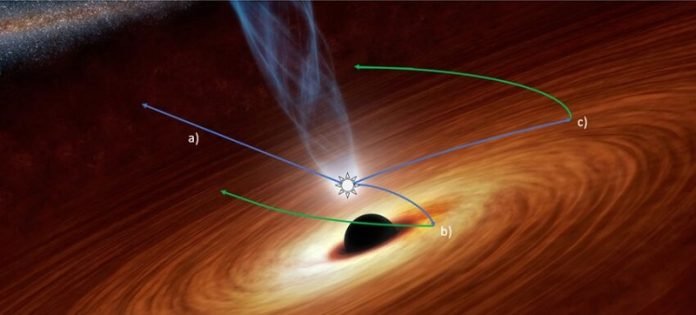
Scientists have developed a novel method to measure the distance to black holes and study the elusive black hole population located at the heart of our galaxy.
This exciting technique, which also offers a fresh way to calculate how fast the universe is expanding, was developed by a research team from the University of Newcastle and unveiled by the postgraduate researcher, Patrick O’Neill, at a recent National Astronomy Meeting in Cardiff.
First, let’s go over what a black hole is. Imagine a star that has burned out and collapsed, creating an incredibly compact object with a gravitational pull so powerful that even light can’t escape from it.
That’s a black hole. Despite the fact that they’re “black,” their presence is pretty noticeable due to the effect they have on nearby materials.
You see, debris and gas orbiting a black hole get sucked into a swirling disk which can become very hot, turning black holes into strong sources of X-rays. Some of these black holes also eject powerful jets of gas and dust over vast distances.
Usually, the distance to black holes is calculated based on their X-ray brightness and their mass, which scientists deduce from the speed at which materials rotate around them. O’Neill’s team, however, took a different approach.
Here’s how it works: The light from a black hole’s jet is scattered in all directions, including towards the swirling disk.
Like a mirror, the disk reflects a portion of this light. This light then ripples outwards from the innermost part of the disk, just like an echo, taking longer to reach the outer parts of the disk.
This phenomenon means we can detect the light from the jet in two different ways: the light that comes directly to us, and the light that’s reflected by the disk.
By keeping an eye on the brightness of both these sources, we can work out the jet’s height above the disk and how close the disk is to the black hole.
By tracking the light from both the jet and its surrounding disk, the team can calculate the size of the disk and how much light it reflects. This provides an exact measurement of the disk’s brightness, and in turn, the distance to the black hole-disk system.
This technique could offer a new way to measure the distance to supermassive black holes in the centers of galaxies. Since X-rays can pass through dense clouds of gas and dust which often block our view, this could help determine the universe’s rate of expansion.
In addition, it’s a valuable tool for studying black holes in our galaxy’s center. Until now, scientists have mostly observed lighter black holes situated away from the galaxy’s plane.
This new method could reveal more about the population of black holes in our galactic center, including possible intermediate mass black holes, which are believed to form from the merging of single-star black holes and potentially act as precursors to the massive supermassive black holes found in the center of most galaxies.
O’Neill expresses his excitement about this new technique and its potential to uncover hidden secrets of our galaxy and the universe’s future.
Now, the team plans to further investigate the population of black holes at our galaxy’s center, hoping to shed more light on the evolution of our galaxy and the behavior of black holes.
Follow us on Twitter for more articles about this topic.



